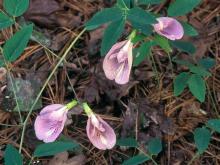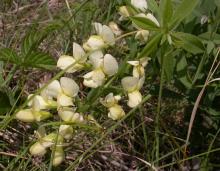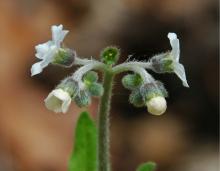Wildflowers, Grasses and Other Nonwoody Plants
Media

Species Types
Scientific Name
All true grasses (species in the grass family)
Description
Missouri has 276 species in the grass family, including well-known crop plants and our native prairie grasses. Distinguishing between the species can be difficult, but it’s easy to learn some basics about the group.
Media

Species Types
Scientific Name
Blephilia ciliata
Description
Square, unbranching stems, opposite leaves, two-lipped flowers, and a mild minty fragrance are clues Ohio horsemint is in the mint family. Tight, rounded flower clusters are stacked atop one another at the stem tips.
Media

Species Types
Scientific Name
Prunella vulgaris
Description
A square-stemmed plant with opposite leaves, self-heal bears two-lipped blue, lavender, or violet flowers in a cylindrical head. We have two varieties of self-heal in Missouri, one native and one introduced.
Media

Species Types
Scientific Name
Aquilegia canadensis
Description
Native to much of eastern North America, eastern red columbine's range almost matches the breeding territory of the ruby-throated hummingbird, its number-one pollinator. Its bloom time matches the hummingbird's northward migration, too.
Media

Species Types
Scientific Name
Clitoria mariana
Description
Butterfly pea is a low, shrubby, or twining perennial in the pea family, with showy, butterfly-like flowers. The leaves are compound with three leaflets. This species grows in the southern parts of Missouri, in acid soils.
Media

Species Types
Scientific Name
Baptisia bracteata (formerly B. leucophaea)
Description
Long-bracted wild indigo flowers April–June, while the surrounding vegetation is still short. Its racemes of creamy-white pea flowers mature into oval pods with tapering beaks.
Media

Species Types
Scientific Name
Scutellaria incana
Description
Showy clusters of blue-violet, two-lipped flowers adorn downy skullcap. This native mint is found mostly in the southern half of the state.
Media

Species Types
Scientific Name
Cynoglossum virginianum
Description
Wild comfrey has large basal leaves that are soft, hairy, and elliptical with long petioles — they look like hounds’ tongues! The upright flowering stalk has few leaves and looks like a wand.
Media

Species Types
Scientific Name
Antennaria parlinii
Description
Plainleaf pussytoes, named for its fuzzy flower heads, is one of the few flowering plants in Missouri that grows well in dry and shaded areas. It’s also an indicator of acid soils.
Media

Species Types
Scientific Name
Lippia lanceolata (formerly Phyla lanceolata)
Description
Common in almost any kind of moist, wet or muddy habitat, fog fruit bears interesting round, purple flower heads that are ringed by small, white or pinkish flowers.
See Also
About Wildflowers, Grasses and Other Nonwoody Plants in Missouri
A very simple way of thinking about the green world is to divide the vascular plants into two groups: woody and nonwoody (or herbaceous). But this is an artificial division; many plant families include some species that are woody and some that are not. The diversity of nonwoody vascular plants is staggering! Think of all the ferns, grasses, sedges, lilies, peas, sunflowers, nightshades, milkweeds, mustards, mints, and mallows — weeds and wildflowers — and many more!





















